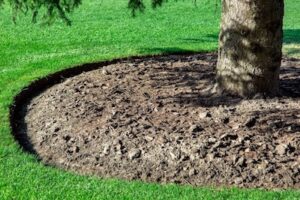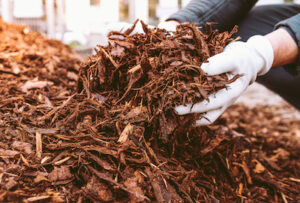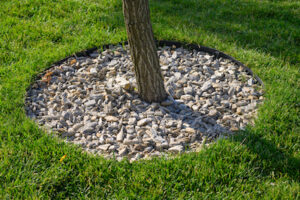How to Guide for Tree Mulching: Home DIY
Mulching trees is an essential part of maintaining a healthy and beautiful landscape. Mulching helps to conserve moisture, suppress weeds, and regulate soil temperature. It also provides a protective layer for the tree roots against extreme weather conditions. So, how do you properly mulch trees on your landscape?
Here are some of the key home DIY guide steps for tree mulching your landscape:
- Choose the Right Mulching Material
- Gather the Necessary Tools
- Prepare the Tree Base
- Apply the Mulch
- Water the Mulch
- Maintain the Mulch
While mulching trees is a simple and affordable DIY project, there are times when mulching can be a complex process that may be better or require the expertise of a tree mulcher service. If you decide to do this DIY, you will need to make sure to do it properly.

Benefits of Mulching Trees
Before we dive into how to mulch the trees in your yard, let’s go over the several benefits of mulching trees. One of the most significant benefits of mulching is that it conserves moisture by reducing water evaporation from the soil surface. This reduces the frequency of watering, saving you time and money. Mulching also insulates tree roots from extreme temperatures, keeping them cooler in the summer and warmer in the winter.
Mulch also helps to suppress weed growth, reducing the competition for water and nutrients with the trees. This results in healthier trees with improved growth rates. Mulch also enhances soil fertility by decomposing and enriching the soil with organic matter, which improves soil structure and drainage.
Steps for How to Mulch Trees
Mulching is an essential practice in tree care that offers numerous benefits to your landscape. It helps to retain soil moisture, suppresses weed growth, insulates tree roots from extreme temperatures, and improves soil structure and fertility. Mulching also enhances the aesthetics of your home’s outdoor space. Mulching trees is not only easy and affordable, but it is also a great DIY project that you can undertake at home.
Here are some steps and tips for mulching trees:
1. Choose the Right Mulching Material
The first step in mulching trees is to choose the right mulching material. The most commonly used mulching materials are wood chips, shredded leaves, compost, pine straw, and grass clippings. However, wood chips are the best option for mulching trees because they decompose slowly and are long-lasting.
2. Gather the Necessary Tools
The next step is to gather the necessary tools for mulching trees. You will need a wheelbarrow or a bucket, a rake, and a pair of gloves. You may also need a shovel or a pitchfork to spread the mulch evenly.
3. Prepare the Tree Base
The third step is to prepare the tree base by removing any weeds, grass, or debris around the tree. Use a shovel or rake to loosen the soil and create a 2-4 inch deep circular trench around the tree. The trench should extend to the drip line of the tree, which is the area where the tree’s branches extend.
4. Apply the Mulch
Once you have prepared the tree base, it’s time to apply the mulch. Spread the mulch evenly around the tree base, making sure to create a 2-4 inch layer. Ensure that the mulch is not in contact with the tree trunk, as this can cause rotting and pest problems. Instead, leave a two-inch gap around the trunk.
5. Water the Mulch
After applying the mulch, water it thoroughly to settle it and promote decomposition. The water should penetrate the mulch layer and reach the soil below.
6. Maintain the Mulch
Maintaining the mulch layer is essential to the health of your trees and soil. Follow these tips to maintain the mulch layer:
- Regularly check the mulch layer
- Remove debris regularly
- Keep the mulch layer free from weeds
- Top-up the mulch layer annually to maintain a 2-4 inch depth
- Avoid mulching too close to the tree trunk
- Avoid using weed fabric or plastic sheets
- Mulch at the right time
With these mulch maintenance tips, the mulch will continue to provide benefits to your trees.

Precautions to Take When Mulching Trees
While mulching trees offers numerous benefits, it’s essential to take precautions when mulching. One of the most critical precautions to take is to avoid mulching too close to the tree trunk. Mulch should be at least two inches away from the tree trunk to prevent rotting and pest infestation.
Also, avoid over-mulching, as this can create an oxygen-poor environment that can suffocate tree roots. A depth of 2-4 inches is enough to provide the benefits of mulching without harming your trees.
Additional Tips
So, if you are looking to do it to the best of your ability, here are some additional tips for mulching trees:
- Avoid using freshly chipped wood for mulching, as it can rob the soil of nitrogen as it decomposes. Instead, use aged wood chips or other mulching materials.
- Consider using a soaker hose or drip irrigation system to water your trees instead of overhead sprinklers. This will reduce water evaporation and ensure that the tree roots get enough water.
- Use a native mulch
- Avoid using weed fabric or plastic sheets under the mulch, as they can prevent water and air from reaching the tree roots.
- Be mindful of the type of tree you are mulching. Some trees, such as maple and birch, prefer slightly acidic soil. In this case, you can use pine needles or shredded leaves as mulch.
- Don’t pile the mulch too high against the tree trunk, as this can create a hiding place for pests and diseases.
- Remember to remove any debris or weed growth from the mulch layer regularly to maintain a clean and healthy mulch layer.
- Consider the aesthetic appeal of your mulch. While wood chips are the most practical mulching material, you can mix in other materials such as pine straw or shredded leaves to add variety to your landscape.
- Mulching can be done at any time of the year, but it’s best to do it in the spring or fall when the soil is warm and moist.

Why Hire a Professional Tree Mulching Service?
While mulching trees is a simple and affordable DIY project, there are times when it may be better to hire a professional tree mulching service. Here are some of the reasons why:
Safety
Mulching around trees can be dangerous, especially if you are not experienced in handling heavy equipment such as wood chippers. A professional tree mulching service has the necessary equipment and experience to handle the job safely.
Quality of Work
A professional tree mulching service can provide a more comprehensive and high-quality mulching service. They have access to a wide range of mulching materials and can choose the most appropriate one for your landscape. They also have the experience and knowledge to properly prepare the tree base and apply the mulch layer.
Time and Effort
Mulching trees can be a time-consuming and labor-intensive task, especially if you have a large landscape. Hiring a professional tree mulching service can save you time and effort, allowing you to focus on other important tasks.
Expert Advice
A professional tree mulching service can provide expert advice on how to maintain your landscape and prevent tree damage. They can also identify potential tree problems and offer solutions to address them.
What to Consider When Hiring a Professional Tree Mulching Service
Choosing a tree mulching professional requires careful consideration of various factors. You should look for a professional with experience and expertise, a positive reputation, licensing and insurance, high-quality equipment and materials, fair pricing, good communication and customer service, and a commitment to eco-friendly practices. Finding the right professional ensures that your trees remain healthy and your garden looks beautiful.
In Closing
In conclusion, when it comes to maintaining your garden or property, tree mulching is an essential task that can help keep your trees healthy, reduce soil erosion, and add nutrients. Choosing the right mulching material, preparing the tree base, applying the mulch, and maintaining the mulch layer are essential steps in mulching trees. Remember to take precautions such as avoiding over-mulching and mulching too close to the tree trunk. By following this DIY guide, you can create a beautiful and healthy landscape for your home.
